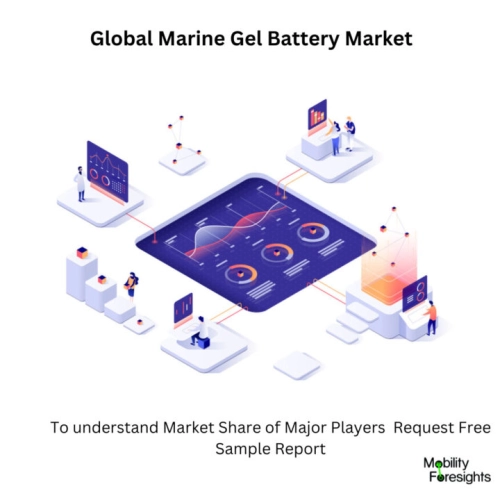
- Get in Touch with Us

Last Updated: Apr 26, 2025 | Study Period: 2023-2030
In order to make a solid, immobile gel-like substance, sulfuric acid and fumed silica are combined to form gel cell batteries. The GEL cell allows for the flow of electrons between the plates without the risk of spilling, therefore the battery does not need to be kept upright. The advantage of gel batteries over traditional lead-acid batteries is their minimal electrode wear, which contributes to a longer service life.
Gel batteries cannot provide strong cold start currents in a short period of time due to their higher internal resistance.The typical lifespan of a 12-volt Gel or AGM battery is up to six years if kept charged when not in use. The battery still has its original capacity after five or six years of float voltage at an average ambient temperature of 25 degree celsius.
Although needing minimal to no maintenance, gel batteries are now more expensive than wet lead-acid batteries. Cell phones, camcorders, electric cars, and marine equipment all frequently employ gel batteries.
The majority of their applications are in electric automobiles due to their spill-proof batteries. Gel batteries are utilised in floor scrubbers, golf carts, recreational vehicles (RVs), and other devices due to their prolonged discharge powers.

The Global marine gel battery market accounted for $XX Billion in 2022 and is anticipated to reach $XX Billion by 2030, registering a CAGR of XX% from 2023 to 2030.
Exide Technologies, a maker and recycler of lead batteries, has released its first marine gel-enhanced flooded battery. New case design, maintenance-free operation, and improved ratings are now available with Nautilus Dual Purpose EFB, according to Exide marketing.
The batteries would perform better in marine applications where dual purpose performance was needed, such as for beginning and deep cycle, at a lower cost than AGM batteries. For the recreational boater who needs a dual-purpose product with premium features, there is an untapped middle-tier market opportunity.
The creation of the new technology was sparked by the battery, where cyclic demands were imposed on batteries. Key learnings from the success of EFB in Europe inspired Exide to develop our first-ever maritime EFB product as well as launch our EFB technology for other applications. This product has superior cycling capabilities than a regular flooded product.
| Sl no | Topic |
| 1 | Market Segmentation |
| 2 | Scope of the report |
| 3 | Abbreviations |
| 4 | Research Methodology |
| 5 | Executive Summary |
| 6 | Introdauction |
| 7 | Insights from Industry stakeholders |
| 8 | Cost breakdown of Product by sub-components and average profit margin |
| 9 | Disruptive innovation in theIndustry |
| 10 | Technology trends in the Industry |
| 11 | Consumer trends in the industry |
| 12 | Recent Production Milestones |
| 13 | Component Manufacturing in US, EU and China |
| 14 | COVID-19 impact on overall market |
| 15 | COVID-19 impact on Production of components |
| 16 | COVID-19 impact on Point of sale |
| 17 | Market Segmentation, Dynamics and Forecast by Geography, 2023-2030 |
| 18 | Market Segmentation, Dynamics and Forecast by Product Type, 2023-2030 |
| 19 | Market Segmentation, Dynamics and Forecast by Application, 2023-2030 |
| 20 | Market Segmentation, Dynamics and Forecast by End use, 2023-2030 |
| 21 | Product installation rate by OEM, 2023 |
| 22 | Incline/Decline in Average B-2-B selling price in past 5 years |
| 23 | Competition from substitute products |
| 24 | Gross margin and average profitability of suppliers |
| 25 | New product development in past 12 months |
| 26 | M&A in past 12 months |
| 27 | Growth strategy of leading players |
| 28 | Market share of vendors, 2023 |
| 29 | Company Profiles |
| 30 | Unmet needs and opportunity for new suppliers |
| 31 | Conclusion |
| 32 | Appendix |